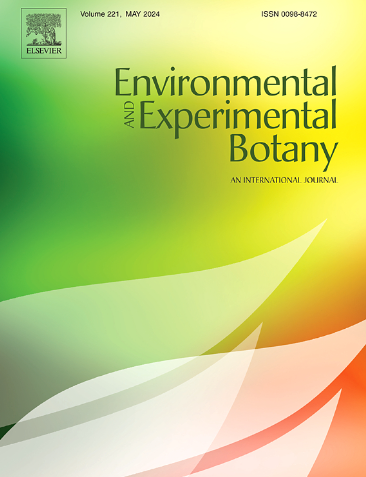Phenylpropanoid derived flavonoid biosynthesis pathway compensates for abiotic and biotic stress tolerance in dhurrin-free forage sorghum
IF 4.7
2区 生物学
Q2 ENVIRONMENTAL SCIENCES
引用次数: 0
Abstract
Sorghum (Sorghum bicolor L. Moench) is a multipurpose cereal valued for its drought tolerance and biomass productivity. Despite its agronomic advantages, the widespread adoption of sorghum as a forage crop is significantly limited by the presence of dhurrin, a cyanogenic glucoside that, upon stress or herbivory, releases hydrogen cyanide (HCN), posing considerable risks to grazing animals. This study systematically investigated the metabolic ramifications of dhurrin elimination in a prussic acid-free (PF) sorghum genotype cultivated under contrasting irrigation regimes. The major aim was to elucidate the consequences of the loss of cyanogenesis on both agronomic performance and the modulation of stress-associated metabolic pathways. Untargeted metabolomics using UHPLC-QTOF-MS revealed significant metabolic reprogramming in PF sorghum, with comparable biomass and no yield penalty. Over 470 metabolites were differentially accumulated, including reduced alkaloids and phenolic acids and increased flavonoids, terpenoids, and jasmonates. Metabolic flux was redirected from dhurrin synthesis toward 4-coumarate-derived phenylpropanoid and flavonoid pathways, boosting antioxidant production. Upregulated jasmonic acid biosynthesis suggests activation of alternative defence signalling. The loss of dhurrin leads to a comprehensive specialization of metabolism favoring antioxidant and hormone pathways without compromising growth, providing key insights for developing safer, resilient prussic acid-free forage sorghum.
苯丙类黄酮生物合成途径补偿无苦豆素饲草高粱的非生物和生物胁迫耐受性
高粱(Sorghum bicolor L. Moench)是一种多用途谷物,因其耐旱性和生物量生产力而受到重视。尽管高粱具有农艺上的优势,但它作为饲料作物的广泛采用受到苦胆素的极大限制。苦胆素是一种产氰的葡萄糖苷,在受到胁迫或草食时,会释放出氰化氢(HCN),对放牧动物构成相当大的风险。本研究系统地研究了在不同灌溉制度下栽培的无普鲁士酸(PF)高粱基因型苦胆素消除的代谢后果。主要目的是阐明失氰对农艺性能和应激相关代谢途径调节的影响。利用UHPLC-QTOF-MS进行的非靶向代谢组学研究显示,PF高粱具有显著的代谢重编程,生物量相当,没有产量损失。超过470种代谢物不同程度地积累,包括减少的生物碱和酚酸,增加的黄酮类、萜类和茉莉酸。代谢通量从苦素合成转向4-香豆酸衍生的苯丙酸和类黄酮,促进抗氧化剂的产生。茉莉酸生物合成的上调表明替代防御信号的激活。苦胆素的损失导致代谢的全面专业化,有利于抗氧化和激素途径,而不影响生长,为开发更安全,更有弹性的无普鲁士酸饲草高粱提供了关键见解。
本文章由计算机程序翻译,如有差异,请以英文原文为准。
求助全文
约1分钟内获得全文
求助全文
来源期刊

Environmental and Experimental Botany
环境科学-环境科学
CiteScore
9.30
自引率
5.30%
发文量
342
审稿时长
26 days
期刊介绍:
Environmental and Experimental Botany (EEB) publishes research papers on the physical, chemical, biological, molecular mechanisms and processes involved in the responses of plants to their environment.
In addition to research papers, the journal includes review articles. Submission is in agreement with the Editors-in-Chief.
The Journal also publishes special issues which are built by invited guest editors and are related to the main themes of EEB.
The areas covered by the Journal include:
(1) Responses of plants to heavy metals and pollutants
(2) Plant/water interactions (salinity, drought, flooding)
(3) Responses of plants to radiations ranging from UV-B to infrared
(4) Plant/atmosphere relations (ozone, CO2 , temperature)
(5) Global change impacts on plant ecophysiology
(6) Biotic interactions involving environmental factors.
 求助内容:
求助内容: 应助结果提醒方式:
应助结果提醒方式:


